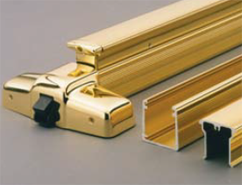Fabrication & Finishing
Anodizing
Anodizing is an electrochemical process that enhances aluminum's natural oxide surface layer by forming an even more durable anodic oxide surface that can accept a variety of (usually translucent) colors.
In the anodizing process, extruded aluminum parts — following a series of cleaning, rinse and etch steps — are immersed in an acid electrolyte bath and an electrical current is passed through the solution. A cathode is mounted to the inside of the anodizing tank, while the aluminum extrusions act as an anode. Oxygen ions are released from the electrolyte and combine with aluminum atoms at the surface of the extrusion being anodized, thereby creating an aluminum oxide layer fully integrated with the underlying aluminum. Dyes can subsequently be applied, with the final step a sealing stage to enhance durability and prevent corrosion.
  |
The resulting oxide layer will not chip or peel, and is extremely hard and corrosion resistant, thus providing outstanding durability and low maintenance costs. Further, a number of colors can be imparted during the anodizing process. These properties lead anodizing to be a popular finishing choice for such applications as architectural products, home appliances, furniture, boats and sporting goods, and personal electronics.
Specific performance characteristics, such as hardness and porosity are dependent upon the alloy being used, the specific anodizing process and chemistry, and the length of treatment time. A number of standard anodic coating designations have been developed; these, along with a more detailed discussion of the anodizing process and variables, can be found by clicking here.
 -
-




 |
|